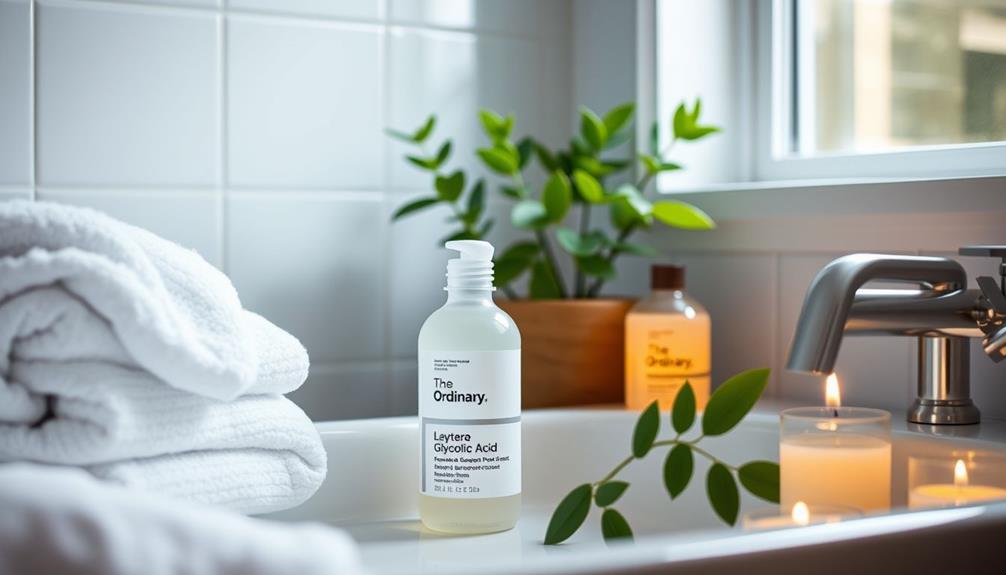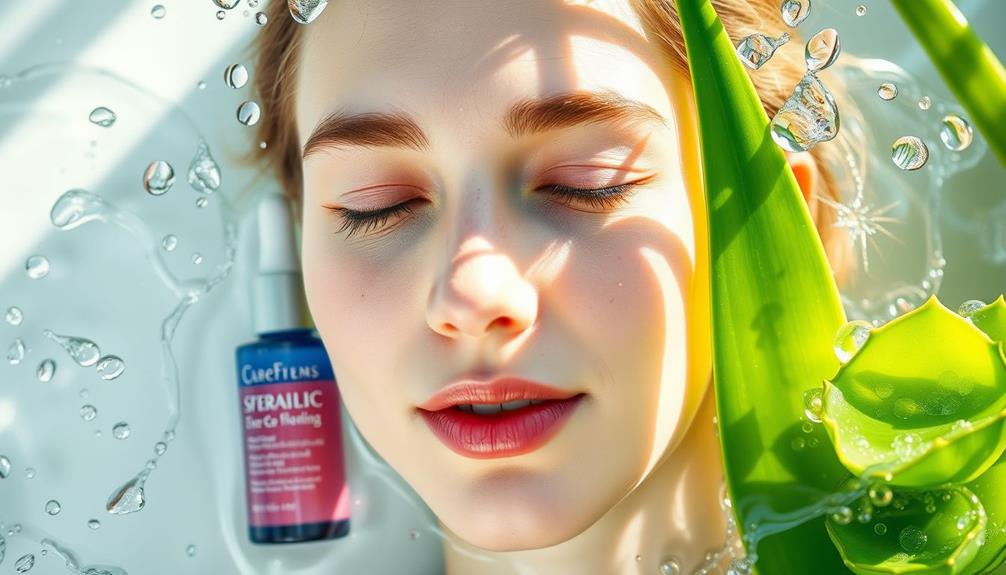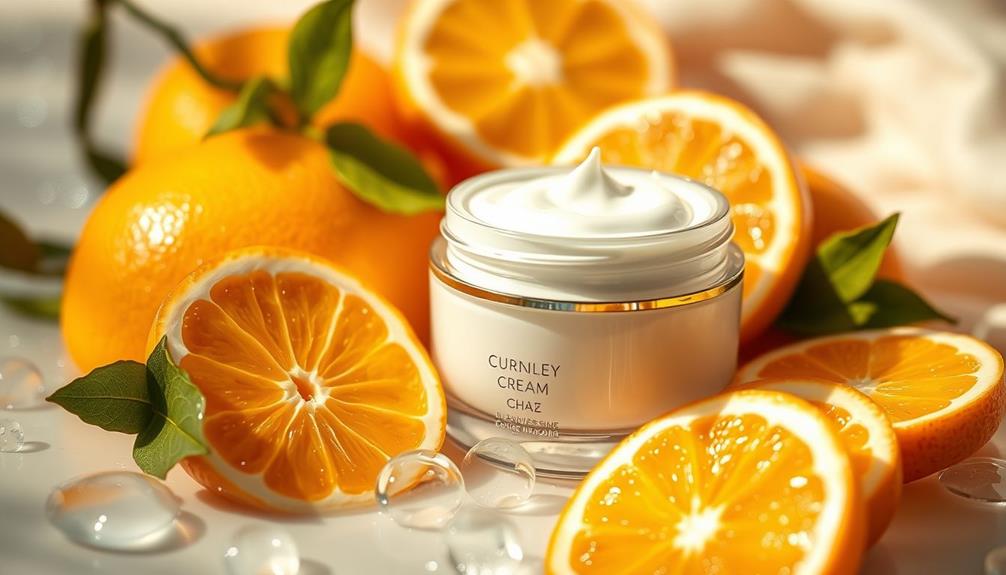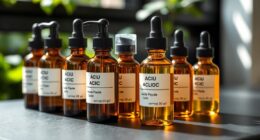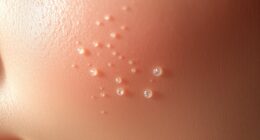Glycolic acid is a game-changer for your skincare routine. It gently exfoliates dead skin cells, revealing a smoother and brighter complexion. You'll notice improved texture and fewer dark spots as it accelerates cell turnover. Plus, it boosts collagen production, helping to reduce fine lines. If you struggle with acne, glycolic acid's antibacterial properties can help unclog pores and prevent breakouts. Remember to use sunscreen daily, as it can increase sun sensitivity. To maximize its benefits and guarantee safety, you'll want to know the best practices, and there's plenty more essential info ahead!
Key Takeaways
- Glycolic acid exfoliates dead skin cells, improving skin texture, tone, and clarity for a radiant complexion.
- It stimulates collagen production, reducing fine lines and wrinkles while enhancing skin elasticity.
- Regular use helps treat acne, unclogs pores, and fades dark spots and hyperpigmentation.
- Always use sunscreen during the day to protect against increased sun sensitivity when using glycolic acid.
What Is Glycolic Acid?
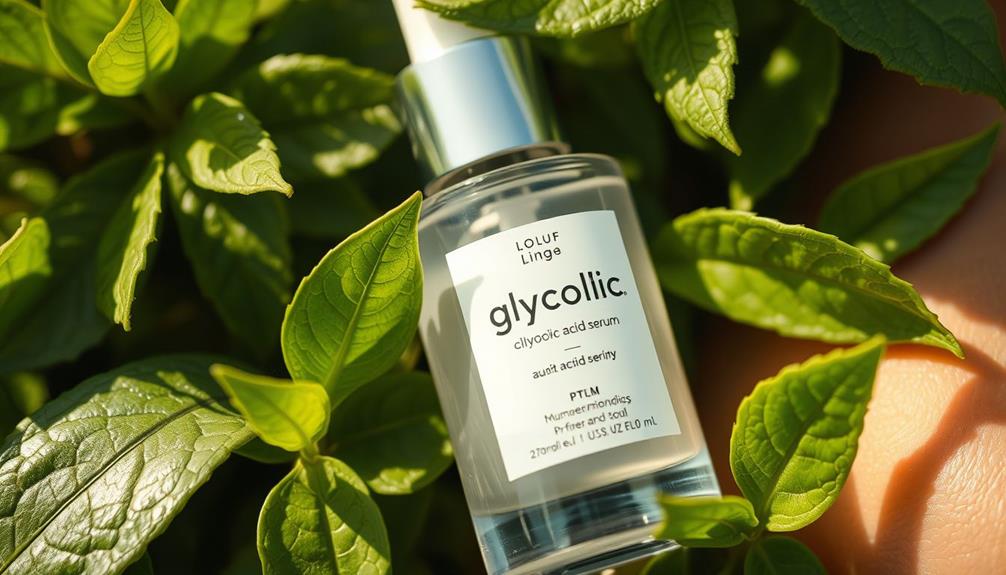
Glycolic acid is a powerful alpha-hydroxy acid (AHA) derived from sugarcane, known for its ability to penetrate deeply into the skin and promote effective exfoliation.
This potent ingredient boasts excellent exfoliating properties, making it ideal for shedding dead skin cells and improving your skin texture. By regularly incorporating glycolic acid into your routine, you can help diminish acne, pigmentation issues, and various signs of aging.
Additionally, essential oils, such as lavender oil known for its calming properties, can complement your skincare routine by promoting relaxation and reducing stress, which may further benefit your skin's appearance.
What sets glycolic acid apart is its small molecular size, which allows it to reach deeper layers of your skin, stimulating collagen production. This boost in collagen not only enhances your skin's firmness and elasticity but also helps reduce the appearance of fine lines and wrinkles.
However, if you have sensitive skin, it's important to start with lower concentrations, as higher levels can lead to irritation.
With glycolic acid products typically ranging from 5% to 70%, you'll find options tailored to your specific skin concerns. Whether you're tackling acne or combating signs of aging, understanding how glycolic acid works can help you make informed choices for your skincare regimen.
Benefits for Your Skin
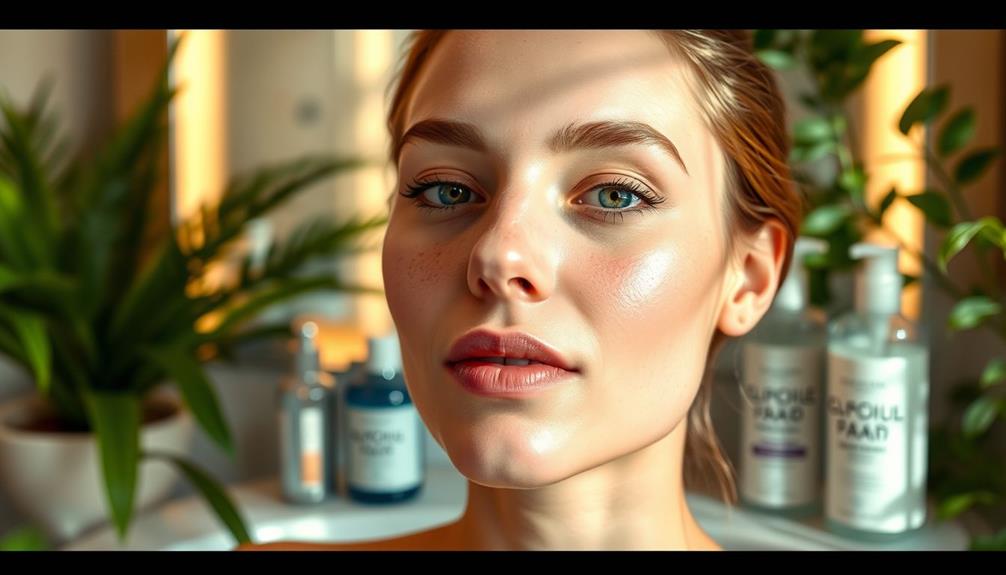
Glycolic acid offers a range of benefits for your skin, starting with its powerful exfoliation that renews your complexion.
This exfoliation not only removes dead skin cells but also promotes the absorption of other skincare products, enhancing their effectiveness.
It also enhances hydration and firmness while tackling issues like acne and dark spots.
By incorporating glycolic acid into your routine, you can achieve smoother, brighter, and healthier-looking skin.
For additional insights on skin health, consider exploring aromatherapy techniques.
Exfoliation and Skin Renewal
How can exfoliation and skin renewal transform your complexion?
With glycolic acid, you're tapping into a powerful tool for achieving smoother, more radiant skin. This alpha hydroxy acid excels at promoting cell turnover, effectively shedding dead skin cells that can dull your appearance. By encouraging this exfoliation, glycolic acid enhances your skin texture, leaving it fresh and youthful.
Additionally, incorporating somatic therapy techniques can further support your skin health by reducing stress, which often contributes to skin issues.
Regular use of glycolic acid stimulates collagen production, which plays an important role in reducing fine lines and improving overall skin firmness. If you struggle with hypopigmentation or dark spots, glycolic acid can help fade these areas by regenerating skin cells and minimizing melanin production.
For those prone to breakouts, glycolic acid is a game-changer. Its exfoliating properties unclog pores, making acne prevention easier than ever. You'll notice not just clearer skin, but a revitalized complexion that reflects your inner energy.
Embracing glycolic acid in your skincare routine means you're investing in effective exfoliation and skin renewal—two fundamental steps for achieving the healthy, glowing skin you desire.
Enhanced Hydration and Firmness
Harnessing the power of glycolic acid, you can greatly boost your skin's hydration and firmness, leading to a more youthful and radiant complexion. Glycolic acid acts as a humectant, attracting moisture to your skin cells, which enhances hydration and plumps up your skin. By stimulating collagen production, it helps improve firmness, effectively reducing the visibility of fine lines and wrinkles over time.
Additionally, glycolic acid promotes increased cell turnover, which aids in retaining moisture and contributes to overall skin elasticity. Regular use can lead to a more even skin texture, allowing you to enjoy that youthful complexion you desire. Studies show that glycolic acid also enhances the absorption of other moisturizing ingredients in your skincare routine, maximizing your hydration efforts.
Here's a quick overview of the benefits:
| Benefit | Description | Result |
|---|---|---|
| Enhanced Hydration | Attracts moisture to skin cells | Plumper appearance |
| Improved Collagen Production | Boosts firmness and reduces fine lines | Smoother skin texture |
| Increased Cell Turnover | Retains moisture and elasticity | Youthful, radiant complexion |
Incorporate glycolic acid into your regimen for these remarkable benefits!
Acne and Dark Spot Treatment
Regularly using glycolic acid can effectively treat acne and fade dark spots, promoting clearer and more even-toned skin. This powerful ingredient works wonders for those dealing with mild to moderate acne by exfoliating the skin, preventing clogged pores, and reducing breakouts. As it helps to slough off dead skin cells, glycolic acid also accelerates cell turnover, revealing brighter, healthier skin beneath.
Additionally, for those who enjoy creating a calming atmosphere while caring for their skin, lighting a candle can enhance your skincare routine and relaxation experience, providing a soothing ambiance as you pamper yourself with your skincare regimen candle lighting techniques.
In addition to combating acne, glycolic acid is particularly effective in fading dark spots and hyperpigmentation. It targets mixed-type and epidermal melasma, improving overall skin radiance and creating a more uniform complexion. Regular use stimulates collagen production, enhancing the skin's elasticity and texture.
For best results, consider combining glycolic acid with microneedling, which greatly boosts the reduction of acne scars. This duo can provide a more effective treatment than either method alone.
With consistent application, you'll notice not only a decrease in acne but also a considerable improvement in the appearance of dark spots, leading to a glowing, revitalized complexion. Embrace glycolic acid for a clearer, more radiant you.
How Glycolic Acid Works
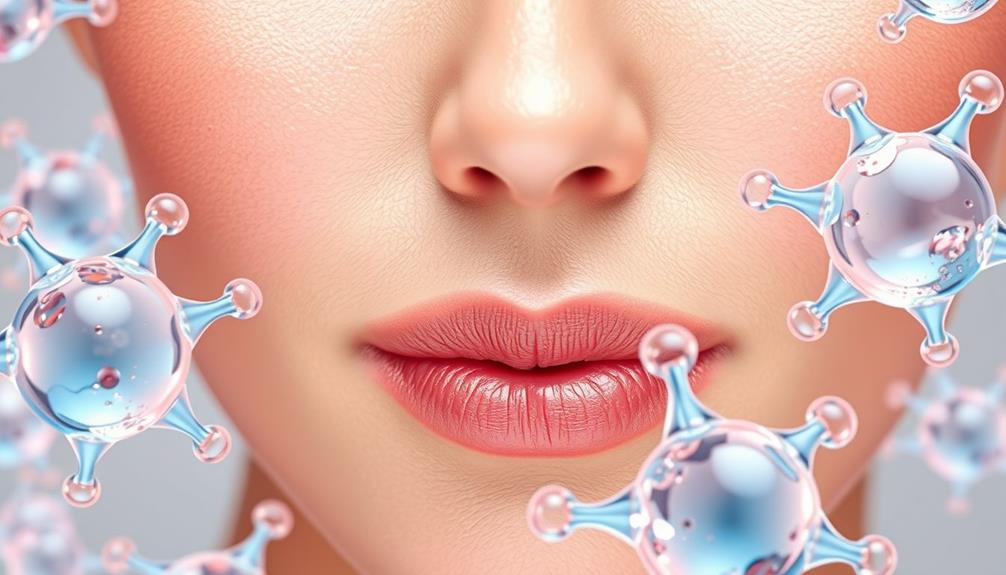
Glycolic acid, the smallest alpha-hydroxy acid, penetrates the skin effectively to exfoliate dead skin cells and promote a brighter, smoother complexion. By breaking down the bonds between corneocytes, it accelerates cell turnover, revealing fresh, smooth skin underneath. This process not only improves skin texture and tone but also enhances overall radiance.
| Benefits of Glycolic Acid | Details |
|---|---|
| Exfoliating | Removes dead skin cells |
| Collagen Production | Stimulates fibroblasts for firmness |
| Acne Treatment | Inhibits acne-causing bacteria |
In addition to its exfoliating properties, glycolic acid boosts collagen production, helping to reduce the appearance of fine lines and wrinkles. Whether you have oily, dry, or combination skin, this versatile ingredient works for various skin types. Its antibacterial properties make it particularly effective for acne treatment, ensuring you can achieve clearer, smoother skin. Regular use of glycolic acid can lead to noticeable improvements in texture and overall skin health, making it an essential component of your skincare routine.
Recommended Usage Guidelines

To get the best results from glycolic acid, start with lower concentrations and gradually increase usage based on how your skin reacts.
Begin with glycolic acid products containing 5-10% concentration, especially if you have sensitive skin.
It's essential to apply glycolic acid at night to minimize sun sensitivity, and don't forget to use a broad-spectrum sunscreen during the day.
To incorporate glycolic acid into your routine, gradually introduce it by starting with 2-3 applications per week.
Observe your skin's response and increase the frequency if you don't experience any skin irritation.
Avoid using glycolic acid alongside other strong exfoliants or retinoids, as this can heighten the risk of irritation.
Before diving in, always perform a patch test on a small area to guarantee you won't have any adverse reactions to new glycolic acid products.
This simple step can save you from potential discomfort.
Potential Side Effects

Using glycolic acid can sometimes lead to skin irritation, including redness, itching, and burning, especially if you have sensitive skin or are using higher concentrations.
If you're new to glycolic acid, it's best to start with lower concentrations and gradually increase as your skin adapts. Higher concentrations, particularly those above 10%, can heighten the risk of side effects.
Prolonged use may increase the likelihood of developing contact dermatitis, which can cause inflammation and worsen existing skin conditions. It's essential to monitor how your skin reacts and to adjust usage accordingly. If you notice persistent irritation or discomfort, consider consulting a dermatologist for personalized advice.
Additionally, glycolic acid can make your skin more sensitive to sunlight. To protect your skin, you should incorporate sunscreen into your daily routine. This will help minimize the risk of sunburn and further irritation.
While glycolic acid is generally safe for most skin types, those with pre-existing skin conditions or sensitivities must exercise caution. Always prioritize your skin's health and don't hesitate to seek professional guidance if needed.
Best Products to Use
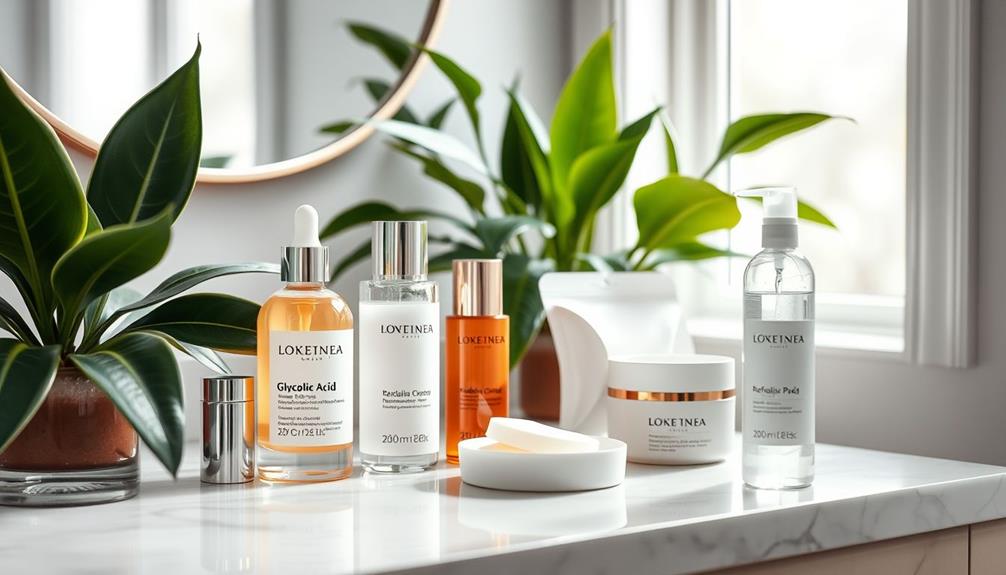
When you're choosing glycolic acid products, it's important to look for concentrations between 5% to 10% for safe at-home use.
You'll find various formulations like serums and toners that can effectively enhance your skincare routine.
If you're considering a more intensive treatment, professional options with higher concentrations might be worth exploring.
Recommended Glycolic Acid Concentrations
For those new to glycolic acid, starting with a concentration of 5% to 10% helps minimize irritation while still delivering effective exfoliation. Over-the-counter products usually feature these concentrations, making them accessible for gradual skin improvement without the need for professional supervision. If you have sensitive skin, sticking to this range is crucial to avoid potential discomfort.
As you become accustomed to glycolic acid, you can explore products with up to 10% concentration, typically recommended for maintaining skin health. Regular application—about two to three times per week—guarantees you reap the benefits without overwhelming your skin.
For a more aggressive treatment, professional chemical peels can use much higher concentrations, ranging from 30% to 70%. However, these should only be performed under healthcare supervision to guarantee safety and effectiveness.
Additionally, consider products that combine glycolic acid with hydrating ingredients. This combination can enhance tolerance, making serums with lower concentrations suitable for daily use. By choosing the right glycolic acid concentrations, you can achieve the best results while prioritizing your skin's well-being.
Topical Formulations to Consider
Choosing the right topical formulations can greatly enhance your skincare routine and maximize the benefits of glycolic acid.
Look for glycolic acid products with concentrations between 5% to 10% for at-home use, as these are effective yet gentle enough for most skin types.
Cleansers and toners with glycolic acid are excellent starting points; they prepare your skin and enhance the absorption of other treatments.
For more targeted results, consider serums that contain glycolic acid. These formulations can penetrate deeper, offering more pronounced effects on your skin's texture and tone.
Always check the pH level of the products you choose; a pH around 4 is ideal for better compatibility with your skin, optimizing the efficacy of glycolic acid.
While at-home formulations are beneficial, remember that professional-grade peels contain much higher concentrations (up to 70%) and should only be done under healthcare supervision for safety.
Professional Treatment Options Available
Professional glycolic acid treatments deliver powerful results, often utilizing concentrations between 20% and 70% to achieve deeper exfoliation and rejuvenation.
These treatments, typically performed by licensed dermatologists or estheticians, can greatly improve skin texture, tone, and clarity, especially when addressing acne scars and signs of aging.
If you're considering these options, it's crucial to seek professional medical advice to guarantee safety and effectiveness.
Here are some popular treatment options:
- Glytone Professional Peel: Offers a strong glycolic acid peeling experience under supervision.
- SkinCeuticals Glycolic Peel: Formulated for safe application, targeting various skin concerns.
- Chemical Peels: Customized treatments for your specific skin type and needs.
- Glycolic Acid Pads: Convenient for maintaining results between visits.
Incorporating these professional treatments with quality over-the-counter products can optimize your results, helping to manage acne, pigmentation, and overall skin health effectively.
Regular treatments will enhance your skin's appearance and wellness over time.
Who Should Avoid It
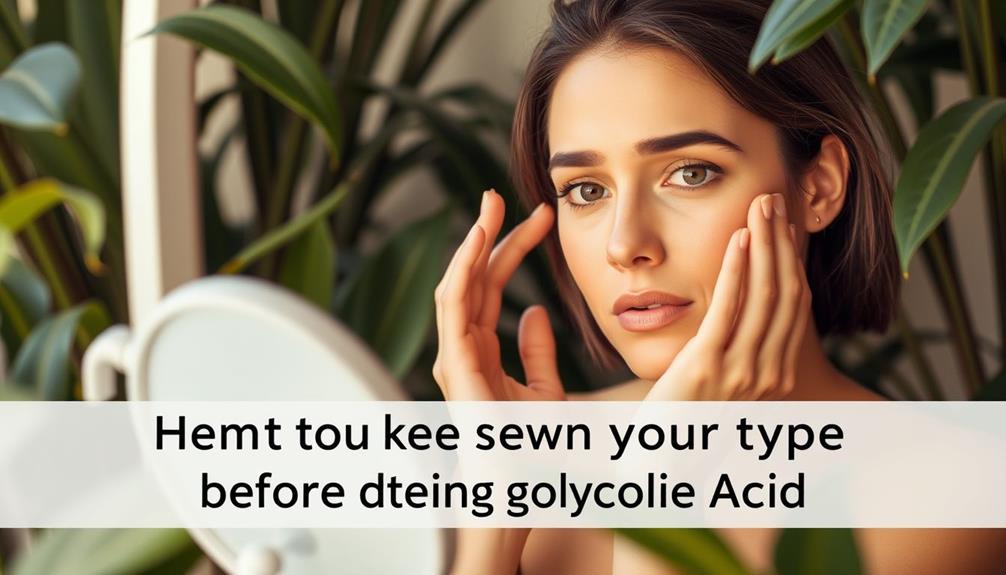
Avoid glycolic acid if you have extremely sensitive skin or conditions like eczema or rosacea, as it can worsen irritation and inflammation. If your skin is prone to these issues, using glycolic acid may lead to increased redness and discomfort.
Additionally, steer clear of glycolic acid if you have open wounds, sunburned skin, or active infections, since it can further irritate your skin and hinder the healing process.
If you've experienced allergic reactions to glycolic acid or other alpha-hydroxy acids in the past, it's best to avoid these products entirely to prevent any adverse effects.
Pregnant or breastfeeding? It's crucial to consult your healthcare provider before using glycolic acid, even though it's generally considered safe for topical application.
Lastly, if you're currently using other potent exfoliants or retinoids, you should avoid combining them with glycolic acid. Mixing these products can increase your risk of excessive irritation and skin sensitivity, leading to more discomfort than desired.
Always prioritize your skin's health and choose products that suit your specific skin needs.
Expert Tips for Application

To achieve the best results with glycolic acid, start with a lower concentration and gradually increase it based on how your skin reacts. This approach helps you gauge your skin's sensitivity and minimize irritation.
Here are some expert tips for effective application:
- Conduct a patch test: Always test a small area of skin to check for any adverse reactions before full application.
- Apply at night: Use glycolic acid products in your evening skin care routine to reduce sun sensitivity and boost efficacy.
- Follow with moisturizer: After applying glycolic acid, use a moisturizer to keep your skin hydrated and reduce potential dryness.
- Use sunscreen daily: As glycolic acid can increase your skin's vulnerability to sun damage, daily sunscreen application is essential during treatment.
Conclusion
Incorporating glycolic acid into your skincare routine can be a game-changer for achieving radiant skin.
Just imagine the smooth, glowing complexion you could reveal with consistent use!
By understanding its benefits and how to apply it correctly, you're taking a step toward healthier skin.
Remember, while it's a powerful ally, it's crucial to proceed with caution.
So, why not give glycolic acid a try and discover what it can do for you?
Your skin will thank you!



